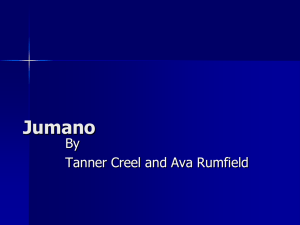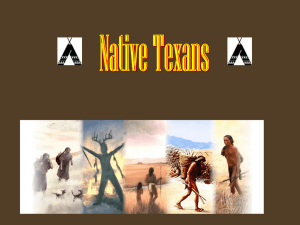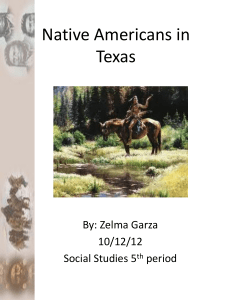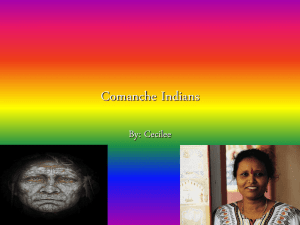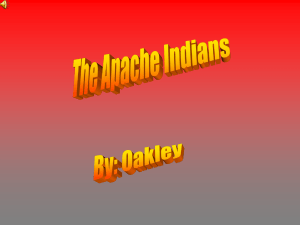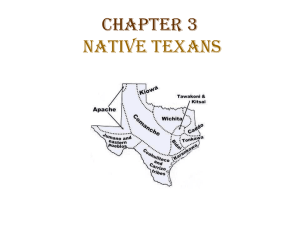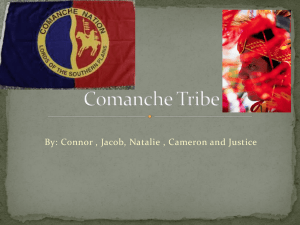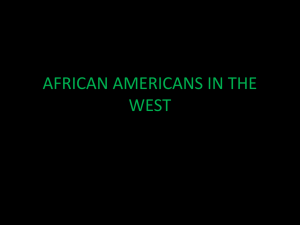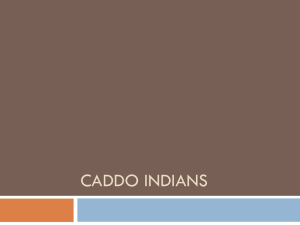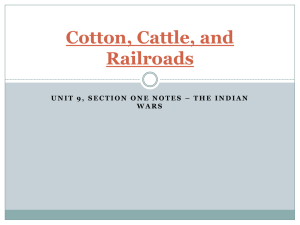Native Americans
advertisement
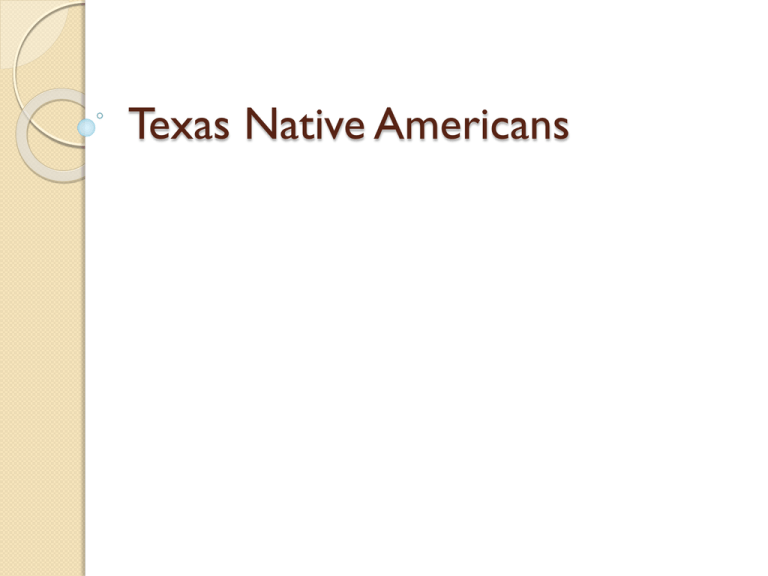
Texas Native Americans The Western Gulf Culture Karankawa Coahuiltecan ◦ Pronounced (coahwheeltecan) Karankawa Hunter-gatherers lived from present day Galveston to Corpus Christi Bay (Gulf Coastal Plains) They were nomads Used dugout canoes to paddle through bays and inlets During the spring and summer, the Karankawa moved away from the coast. They camped near rivers and springs on flat costal prairie. Hunting and Shelter Men hunted with large wooden bows and arrows Traps were used to fish They also hunted deer and small animals They built portable wigwams – circular huts made from bent wooden poles covered with animal skin. Each wigwam could house 7-8 people. Karankawa Clothing Because of hot summers and mild winters not much clothing was worn Men wore a little cloth around the waist, or nothing at all Women wore deerskin or grass skirts They painted themselves with bright colors Alligator fat or dirt was used as insect repellent Karankawa Family Treated children with kindness and much love Children were given two names one known only to close family They believed that the secret name carried magic that protected children from danger Karankawa Ending The Karankawa fell ill and died at an alarming rate in the 1500’s. Why do you think this happened? Coahuiltecan (coahwheeltecan) Were also nomads who hunted and gathered Lived in Southern Texas (South Texas Plain) were the climate was too dry to support farming Their clothing was much like the Karankawa (very little) Both men and women wore long hair, hanging down to the waist Coahuiltecan Tools Archaeologist believe that they did not use many tools They were limited to stone hammers, knives, bows and baskets Coahuiltecan Food Hunted buffalo, deer and small mammals The men dug pits to trap javelinas They started fires to drive animals toward waiting hunters. Their diet included ant eggs, lizards, snakes, spiders and worms Coahuiltecan Night Life They worked hard to survive, but made time for fun! Groups would gather for feasting and dancing at all-night celebrations called mitotes. These gatherings celebrated special events such as religious occasions, victory in battle, or plentiful food supply. Coahuiltecan Shelter They did not build wigwams, but instead placed animal skin over bent branches to sleep and rest under They laid on grass or deerskin beds Coahuiltecan Ending Many died from disease in the 1500’s The survivors adapted to change and began to live among the Spanish abandoning their traditional way of life. The Southeastern Culture Caddo Wichita Atakapa The Caddo (Cad-oh) Moved into eastern Texas from presentday Arkansas, Louisiana, and Oklahoma more than 1,000 years ago. The rich soil and abundant rain allowed for the growing of crops Caddo Farming The Caddo built permanent villages and became expert farmers Many of their methods are used by Texans today! They used crop rotation – a system of growing different crops on the same land over a period of years. This prevents the soil from wearing out. They set aside seeds for the next years crops Practiced slash and burn farming. Burned forest to provide land for growing crops. Grown were beans, corn, squash, sunflower seeds, and tobacco. In most Texas Indian groups women farmed, BUT the Caddo valued farming so highly that the men shared farming responsibility. Men cleared the fields and made farming tools. Tools were hoes made of wood, or shoulder blades of buffalo. Caddo Society Large population because of plentiful constant supply of food This allowed some people to take on special jobs. They were organized into three confederacies – these groups shared a common language and were allies. Allies-friends who supported one another. Each confederacy built temples and mounds that were used for religious events. These mounds were also used as burial sites for important religious or political leaders. Matrilineal Society Families were traced through the mother’s side. When couples married they lived with the wife’s family Women made the important decisions concerning the family. Shelter The men built sound sturdy houses. They would plaster the outside of their houses with mud. Caddo Hunting and Fishing When fishing they would bait a series of hooks and tie them to a string that was stretched across a creek. They used bow and arrows to hunt deer, buffalo and small animals. Clothing During the cold winter months men and women wore clothing made from animal skins. In the summer they wore deerskin breechcloth. Women wore clothes/skirts made from grass and straw. They tattooed their bodies and would also wear paint. Caddo’s and Europeans The Caddo were one of the first tribes the Europeans met. Despite the difficulties the Europeans brought the Caddo played an important role in Texas history. The Wichita Lived to the west of the Caddo along the Red River. They like the Caddo had a confederacy with 4 different groups. ◦ ◦ ◦ ◦ Waco Taovaya Tawakoni Wichita Wichita Arrival The Wichita were originally from Kansas and Oklahoma. They moved into North Texas in the 1700’s. This was after the Spanish had brought horses into the area. Wichita Life They used horses to hunt buffalo and deer. They lived along creeks and rivers, where they grew beans, corn, melon, and squash. Physical Characteristics Like the Caddo, they tattooed their bodies. Women tattooed circles around their eyes and lines from their lips to their chins. Men tattooed their eyelids and a short line at the corner of each eye. This made them look like raccoons! They called themselves raccoon eyes. The Atakapa Lived from Galveston Island to the Sabine River and into present day Louisiana. Part lived close to the coast and others lived more inland. Atakapa by the Coast The land wash marshy. Saltwater sometimes flooded the land, so farming was impossible in this area. They used wooden fish traps. They also used canoes to gather shellfish which they raked from the sea bottom. The Inland Atakapa The Atakapa who lived inland from the gulf farmed. They grew several vegetables, but corn was their primary crop. They may have learned how to farm from the Caddo. They also hunted wild game with bows. Part of their diet were alligators and buffalo. The Pueblo Culture Only had one tribe called the Pueblo. Today they are called the Jumano. The Jumano In Northern New Mexico a group of people called the Pueblo lived as farmers. They built permanent houses cut out of adobe – Made by drying clay bricks in the sun. Sometime between the years 1000 and 1200 they moved into Texas along the Rio Grande. Name Change Pueblo Jumano The Pueblos who moved south down the river are known today as the Jumano. Adobe villages were built along the Rio Grande. Jumano Food They grew crops despite the intense heat and dry summers. Farming was done close to the Rio Grande. Advantages/disadvantages? The Jumano gathered wild plants for nourishment. Buffalo was their main source of protein. Jumano Expansion Some Jumano became Nomads. They moved into the plains of western and central Texas. They supplied their brothers near the Rio Grande with meat and hides. The Jumano had many allies. Trading was done with tribes to the east and west. Villages near the Rio Their villages were huge! They had 10,000 people living in only five villages. We have less than 700 students attending Tolar I.S.D.! Houses The houses held around 30-40 people. They built multiple houses around a central plaza. Jumano houses were made of wood and adobe which helped keep they cool. The roofs were flat and made from tree branches. They often painted the inside of their houses with vibrant colors. Not all Jumano lived in the village. Some lived in separate adobe houses or grass huts. The Jumano nomads lived in temporary shelters made from animal hide or grass. Jumano Battle Trading was done with allies, but they also had enemies. Apache and Jumano did not get along. The Jumano would fight with heavy clubs and shields made of buffalo hide. They were experts at molding hides into clothing and protection, this was done by beating the hide with stone. Appearance Jewelry was made of copper, coral and turquoise. Clothes were made from animal hides. Tattoos were striped down their faces. Jumano Hair Women wore their hair long and tied it to the head with a hair band. Men shaved it all except on the middle of the head. They would leave a little mohawk down the middle of the head and on the very top a long lock of hair which was fastened with feathers. They would paint the mohawk. Disease, Drought, and Apache In the 1500’s the Spanish arrived and befriended the Jumano. The two traded Jumano goods for Spanish horses. Spaniards also introduced disease to the Jumano. This killed much of the tribe. Drought Drought hit Texas very hard in the 16 and 1700’s. This dried up many of the rivers and farming became very difficult. Much of the grass also died driving the buffalo to move away. The tribe was left with no way to irrigate and nothing to hunt. The Last Straw The Apache constantly attacked the Jumano. Apache’s longed for the Jumano’s trade connections and hunting ground. In the early 1680’s Juan Sabeata asked the Spanish for protection against the Apache. Juan Sabeata had once lived with the Spanish, but adopted the Jumano way of life. Although Sabeata knew many Spaniards his request was ignored. Survivors Any Jumano that survived joined other tribes or adopted the Spanish way of life. The Plains Culture Area The Great Plains stretch from Canada into Southern Texas. Native Americans of the Plains hunted buffalo. They would hunt them by foot, sometimes chasing a herd off a cliff to kill many at once. Plains Tribes Tonkawa Apache Comanche Kiowa Tonkawa The Tonkawa lived on the North-Central Plains of Texas (Edwards Plateau). They lived in tepees – Movable homes made of animal hide stretched over long wooden poles. Tonkawa Food The Tonkawa depended on the buffalo for their food, clothing, and shelter. They also gathered wild berries nuts and wild vegetables. They were nomads. Tonkawa Physical Characteristics The men wore their hair long and parted down the middle. Women wore their hair either long or short. Both men and women painted their bodies. They wore very little clothing. Tonkawa Ending In the 1700’s the Tonkawa were driven from their hunting grounds – areas where they hunted for food. The Apache forced them to move and took over their grounds. Tonkawa’s tried to adjust and become farmers, but had little success. By the 1900’s the Tonkawa no longer existed as a separate Indian group. Apache Originally lived in Canada. They migrated into the American Southwest between the year 1000 and 1400. Two Apache groups ◦ Lipan ◦ Mescalero (Moved from Texas to New Mexico in the 1700’s) Apache Bands Bands-small groups made up of a few families Apache bands would travel, hunt and fight together. These bands lived close together for defense against other Indians and also for ceremonies. Apache Hunting Horses aided in hunting Hunted in teams to herd buffalo and kill many at one time Butchering buffalo and using every piece of the animal ◦ They would dry the meat in the sun, cutting it into thin slices. ◦ When it was dry they would grind it, like flour for later consumption. They would stretch the hides over branches and make tub-shaped boats. Lipan Apache Some Lipan Apache farmed which was unusual for Plains Indians. They grew beans, corn, pumpkins, and watermelon. When the buffalo moved the Lipan followed sometimes leaving their crops. The Lipan who did not farm would travel to New Mexico to trade meat and hides for vegetables. What Did They Look Like? Men would cut their hair very short on the right side, but allow the hair on the left of the head to grow long. Men tied feathers and decorations to their hair. Men would pluck their beard and eyebrow hair! Women wore their hair long Women also wore earrings Apache Behavior Often times they would attack Pueblo villages and Spanish towns. They were, for a period of time, “the bad boys of Texas”. Their tirade would soon end with the arrival of the Comanche. Comanche Originally lived in what is now the Western United States After they acquired horses the Comanche moved into the Great Plains The Comanche did not migrate into Texas until the 1700’s. They moved to Texas to have access to more buffalo and wild horses. Leaders The Comanche lived in bands headed by a peace chief, usually an older man. The best rider and fighter served as the war chief of the band. Hunting Their skill as buffalo hunters made them very wealthy. How did this make them wealthy? Fighting The Comanche were very skilled fighters. They soon controlled much of the plains, including northern and western Texas, which the Spanish called Comancheria. Kiowa The Kiowa were the last Plains group to arrive to Texas. In the 1800’s they moved to the northern plains to escape from enemy attacks. Kiowa men did the hunting and gathering. Hunters/Gatherers The Kiowa did not farm. They hunted buffalo Gathered berries, fruits, and nuts They would trade hides for fruits and vegetables with the neighboring Comanche Kiowa Looks They wore their hair long, but over their right ear their hair was cut short. Kiowa women prepared the buffalo hide, sewed clothing, and made pemmican. Skilled fighters, the Kiowa became allies of the Comanche. They resisted being forced from their Texas hunting grounds. Together the Comanche and the Kiowa fought till the end.
